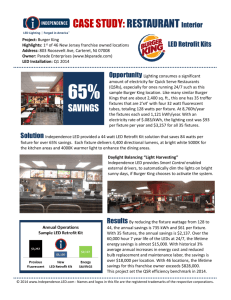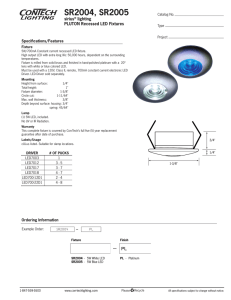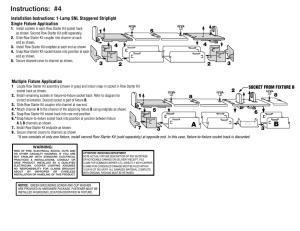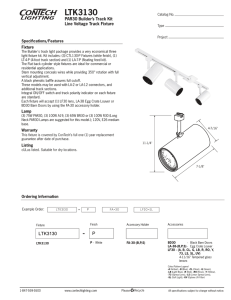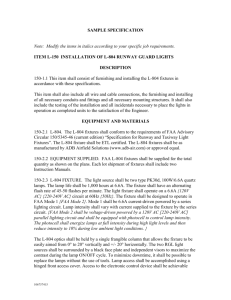Appendix H-2 TEST AND MEASUREMENT REALITIES H2.1 QUALITY CONTROL IN PRODUCTION
advertisement
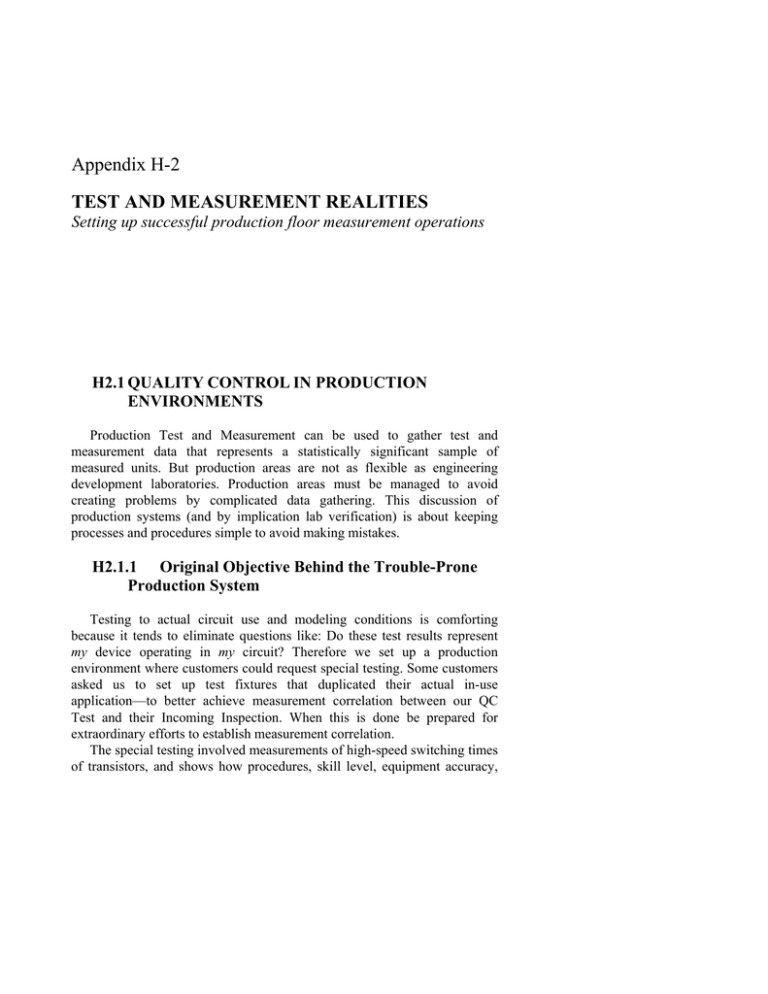
Appendix H-2 TEST AND MEASUREMENT REALITIES Setting up successful production floor measurement operations H2.1 QUALITY CONTROL IN PRODUCTION ENVIRONMENTS Production Test and Measurement can be used to gather test and measurement data that represents a statistically significant sample of measured units. But production areas are not as flexible as engineering development laboratories. Production areas must be managed to avoid creating problems by complicated data gathering. This discussion of production systems (and by implication lab verification) is about keeping processes and procedures simple to avoid making mistakes. H2.1.1 Original Objective Behind the Trouble-Prone Production System Testing to actual circuit use and modeling conditions is comforting because it tends to eliminate questions like: Do these test results represent my device operating in my circuit? Therefore we set up a production environment where customers could request special testing. Some customers asked us to set up test fixtures that duplicated their actual in-use application—to better achieve measurement correlation between our QC Test and their Incoming Inspection. When this is done be prepared for extraordinary efforts to establish measurement correlation. The special testing involved measurements of high-speed switching times of transistors, and shows how procedures, skill level, equipment accuracy, 2 Chapter H-2 and test fixture design issues can create situations that are chaotic, or easy, based on some fundamental management choices. H2.1.2 Correlating Measurements Between Supplier and a User Correlating measurements between a supplier final inspection and a user incoming inspection shows how measurement-to-measurement correlations were set up [61]. The correlation occurred between a semiconductor supplier's final QC and a customer’s incoming inspection for sensitive RFamplifier gain measurements on incoming lots. This example was chosen because the measurements1 were sensitive and prone to problems similar to passing regulatory test. Devices were sensitive and prone to damage. Test setups and devices could oscillate, rendering measurements meaningless and damaging the devices. Stray coupling through power supply and instrument cables were a common problem. These concerns are like testing very high-speed digital boards using today’s deep sub-micron CMOS parts. Before attempting the correlations, certain conditions needed to be true. The product line to be correlated needed: • A track record of repeatability and consistency lot-lot for the parameters to be measured, showing that it was under statistical process control. • Characterized parameters. Characterizing a measured parameter means that the parameter is measured over a range of bias and frequency conditions and on a weighted sample of units of the product line. Judgments applied to the data include positive conclusions that both the device-under-test (DUT) and the test fixture behavior are understood, consistent, well behaved, and predictable. This was important because typical test parameters measured would include such quantities as maximum neutralized RF power gain. The characterization of the process would also show how the product behaved with respect to bias, frequency, temperature, and voltage. The next step was to gather a meaningful sample of DUTs for test setup correlation, once satisfied that repeatable and meaningful measurements could be taken. Weighted samples, with a minimum of 26 units each, represent the process spread over +/- three-sigma range for the measurement taken. A weighted sample includes units from the corners (tails) of the 1 Quantities measured were typically: Available power gain (Gpe) neutralized, at 200MHz; noise figure (NF) at 60MHz; and Vagc, at 30db gain compression and 100MHz. H-2. Test and Measurement Realities 3 normal distribution and may require special lots targeted to the process corners to produce them. The test fixturing and device characterization would show how the product behaved with respect to the customer’s requested test conditions, and whether there would be any issues raised by changes to the standardprocess test-fixture conditions. For example, biasing units at an operating point where they might oscillate, burn up, or suffer other damage. Once we determined that the outgoing-incoming test conditions were acceptable, the task of building test fixtures began. Typical practice called for building six nearly identical (as possible) copies2 of the test fixture. These fixtures would all be correlated against each other at one time by measuring their RF amplification as measured in dB (dB = 20ln(V2/V1 if Z2 = Z1). Correlation would be achieved when a device-under-test unit/transistor would produce the same readings in all of the fixtures. “The same” meant within +/-1dB fixture-to-fixture. The weighted sample of units from the population distribution would have to show such correlation. During fixture correlation, issues would sometimes arise and have to be resolved and defined. Examples of issues would include how the powersupply and signal cables would have to be draped or routed, extra fixture shielding needed, test bench grounding, test-equipment capability, and more. These kinds of problems were almost sure to show up between customer and supplier, between one test operator and another, and from one day to the next. Fixing them and getting repeatability would require very careful definition of the items mentioned: Cable routing, test equipment, etc. After establishing correlation between test fixtures, the task of generating test units would begin. Typical practice called for generating two sets of 15 measured parts. Each set would consist of 5 units around the process minimum, 5 around the process mean, and 5 around the process maximum. Three correlated fixtures and one correlated set of test units would be sent to the customer. The supplier would retain the rest of the test units and fixtures. The customer would set up the test and try to repeat the measurements. At supplier and user the 6 correlated test fixtures and 3 sets of correlated test units would be distributed as follows: • One fixture and 5 units (min-typ-max) would become Golden Standards. These would be very highly protected from damage and very rarely used. 2 Sometimes 9 identical test fixtures would be produced and correlated. Three of them would be archived and hardly ever used except to regenerate test fixtures and calibrated DUTs. The problem was that DUTs were inserted into sockets for the testing and socket contacts wear out after repeated use. 4 Chapter H-2 • One fixture and 5 units (min-typ-max) would become working standards. These would be highly protected from damage and rarely used. • One fixture and 5 units (min-typ-max) would become production standards. These would be protected from damage and used on a daily basis. Production standards would be used to verify production setups. Working standards would be used to re-generate production standards when test units died due to handling and wearout. Golden standards would be used to regenerate working standards. Standards were replaced when they got damaged, drifted, or were lost which was frequent enough due to ESD, handling, and aging. Any production test in long enough use and high enough volume would see the socket or fixture wear out. This would necessitate re-generation of the test fixture. The working standard test fixture would be used to regenerate the production test fixture, and so forth. H2.1.3 The Situation Created by Complexity After some years of following a philosophy of testing to customer test fixtures we3 had many different test fixtures and test setups used in a production QC test area. The magnitude of the switching currents, loading, and RF effects differed from customer to customer, and setup to setup. Usually the switching currents differed by only a small percent from one customer and test fixture to another customer and test fixture. Thirteen product lines shipping thousands of units per week were being QC’d. There were up to 500 test setups that the production floor used. This caused constant set uptear down test fixtures for the different productprocess chip lines. There were many high-speed measurement problems with getting the test setup right, and then constantly changing it. There also were equipment-accuracy and measurement-dispersion4 issues to deal with. This situation was a production-management nightmare. Further issues included correlation between test setups, models, and process controls. Switching-circuit ringing when doing high-speed switching measurements was always a problem. The test fixtures were not engineered and bypassed carefully for high-speed switching. Sometimes the steady state high or low switch state was not actually reached due to excessive ringing. Testing (and/or simulation) is very non-repeatable under such conditions. At the 1 to 10ns switching speeds involved, merely moving a cable or standing 3 4 The experience related in this example comes from the semiconductor supplier industry. Accuracy relates to being close to the correct value. Dispersion relates to random fluctuations and repeatability. H-2. Test and Measurement Realities 5 closer to a test fixture changed test results. Even worse was performing a measurement on a waveform with excessive ringing. There was no such thing as repeatability, verification, and quality control in this situation. H2.1.4 Corrective Action Plan Production test was cleaned up by simplifying (standardizing) it. Customer test fixtures were properly laid out and bypassed. Then these fixtures were correlated to a standardized (high, medium or low switching current) production test fixture in the R&D lab. Copies of these standard high, medium or low switching current fixtures were set up permanently on the production test floor. H2.1.5 Results of Managing for Simplicity and Test Engineering ALL the production problems disappeared and stayed away once the above process improvement steps were accomplished!!! Meaningful comparisons could be made between different chip lines and good and plentiful information was fed to product characterization (data sheets) and statistical process control (SPC) once the production-testing situation came under control. After an investment of about 2-1/2 man-years in process improvement tasks we were able to save 4 man-years per year ongoing of QC and production test support effort. Payback was immediate. The quality of test measurement and verification of results improved from an average of 10% correct to 99%+ correct. H2.1.6 The Lessons Learned Don’t play fancy testing games in a production environment! Run a production environment the way it should be run, well engineered and simple. These lessons can be applied directly to prototype qualification and EDA tool qualification. Don’t mix difficult very-high-accuracy lab-verification (simulator trust-building exercises) exercises with product development programs with tight schedules and tight budgets. Try to do such EDA tool trust building off-line where the truth won’t be subject to schedule pressures. Likewise, don’t design product that must be fine tuned in production, or require super-accurate models because they have no design margin. 6 Chapter H-2 Desensitize the design to variation! Use modeling and simulation what-ifs to predict what will happen in a particular circuit application.
